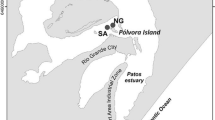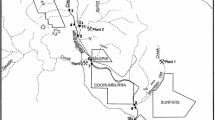Abstract
We present the distribution of Cd and Zn in sediment cores taken under Spartina alterniflora Loisel. marsh and compare with adjacent mud flats without plant cover. Vertical distribution of Cd and Zn in the mud flat and S. alterniflora cores were different. From 0 to 5 cm of depth Zn and Cd concentrations did not change with depth in the two cores but were higher in the mud flat. From 5 to 15 cm, corresponding to maximum root biomass under S. alterniflora, Zn and Cd concentrations remained constant in the mud flat cores, but increased by a factor of nearly 4 under S. alterniflora. Below this depth concentrations dropped in both cores. Manganese distribution in S. alterniflora cores suggests that oxides are precipitated at the depth of maximum root biomass. More oxic environment under S. alterniflora (average Eh = +5 mV) with low sulfide concentration (0.58 mg l-1) relative to the mud flat cores (average Eh = –204 mV; sulfide 47.1 mg l-1), may favor Fe and Mn oxi-hydroxides precipitation, causing an accumulation of Cd and Zn at the root zone. In the mud flat cores, Zn and Cd highest concentrations were at the sediment water interface, where oxic waters favor their precipitation with Fe and Mn oxi-hydroxides. The results discourages the indiscriminate use of salt marsh sediments in environmental monitoring of trace metals, since the possibility of post-deposition mobilization of trace metals due to root metabolism, will make correlation with trace metal loading rates impossible.
Similar content being viewed by others
References
Allen, J.R.L., Rae, J. and Zanin, P.E. 1991. Metal speciation (Cu, Zn, Pb) and organic matter in an oxic salt marsh, Severn Estuary, South West Britain. Marine Pollution Bulletin 21: 574–580.
Aragon, G.T. 1997. Biogeoquímica de sulfetos ferrosos em sedimetos de manguezal da BaÍa de Sepetiba, Rio de Janeiro. PhD Dissertation, Universidade Federal Fluminense, Niteroi.
Armstrong, Y. 1978. Root aeration in the wetland condition. pp. 269–298. In: Hook, D.E. and Crawford, R.M. (eds), Plant Life in Anaerobic Environment. Ann Arbor Science Publucations, Michigan.
Barcellos, C. 1995. Biogeodinâmica de cadmio e zinco na Baía de Sepetiba, Rio de Janeiro. PhD Dissertation, Universidade Federal Fluminense, Niteroi.
Barcellos, C. and Lacerda, L.D. 1994. Cadmium and zinc source assessment in Sepetiba Bay and basin region. Environmental Monitoring and Assessment 29: 183–199.
Boulegue, J., Lord III, C.J. and Church, T.M. 1982. Sulfur speciation and associated trace metals (Fe, Cu) in the pore waters of Great Marsh, Delaware. Geochimica Cosmochimica Acta 46: 453–464.
Chiu, C.Y. and Chou, C.H. 1993. Oxidatio in the rhizosphere of mangrove Kandelia candel seedlings. Soil Science and Plant Nutrition 39: 725–731.
Dyrssen, D. 1985. Metal complex formation in sulphidic seawater. Marine Chemistry 15: 285–293.
Engler, R.M. and Patrick Jr., W.H. 1975. Stability of sulfides of manganese, iron, zinc, copper and mercury in flooded and non-flooded soils. Soil Science 119: 217–221.
Feijtel, T.C., DeLaune, R.D. and Partrick Jr., W.H. 1988. Bio-geochemical control on metal distribution and accumulation in Louisiana sediments. Journal of Environmetal Quality 17: 88–94.
Fiszman, M., Pfeiffer, W.C. and Lacerda, L.D. 1984. Comparison of methods for analysis and geochemical partitioning of heavy metals in sediments from Sepetiba Bay, Rio de Janeiro, Brazil. Enviromental Technology Letters 5: 567–575.
French, P.W. 1993. Seasonal and inter-annual variation of selected pollutants in modern intertidal sediments, Aust Cliff, Severn Estuary. Estuarine Coastal and Shelf Science 37: 213–219.
Gaillard, J.F., Jeandel, C., Michard, G., Nicolas, E. and Renard, D. 1986. Interstitial water chemistry of Villefranche Bay sediments: Trace metal diagenesis. Marine Chemistry 18: 233–247.
Gambrell, R.P. 1994. Trace and toxic metals in wetlands – a review. Journal of Environmental Quality 23: 883–891.
Giblin, A.E., Luther III, G.W. and Valiela, I. 1986. Trace metal solubility in salt marsh sediments contaminated with sewage sludge. EstuarIne Coastal and Shelf Science 23: 477–498.
Graham, M.C., Mackenzie, A.B., Allan, R.L., Cook, G.T., Scott, R.D., Pulford, I. and Livens, F.R. 1993. IR spectroscopy in the investigation of radionuclide binding in salt marsh sediments in SW Scotland. pp. 383–386. In: Allan, R. (ed.), Proceedings of the 9th International Conference on Heavy Metals in the Environment, Toronto. Volume 2. CEP Consultants, Edinburgh.
Gueiros, B.S. 1997. Biogeoquímica de manganes em plaícies de maré da Baía de Sepetiba, Rio de Janeiro. MSc Dissertation, Universidade Federal Fluminense, Niteroi.
Kerner, M. and Wollman, K. 1992. Remobilization events involving Cd and Zn from intertidal flat sediments in the Elbe Estuary during the tidal cycle. Estuarie Coastal and Shelf Science 35: 371–393.
Lacerda, L.D., Pfeiffer, W.C. and Fiszman, M. 1987. Heavy metal availability and fate in Sepetiba Bay, SE Brazil. The Science of the Total Environment 65: 163–173.
Lacerda, L.D., Carvalho, C.E.V., Tanizaki, K.F., Ovalle, A.R. and Rezende, C.E. 1993. The biogeochemistry and trace metals distribution of mangrove rhizospheres. Biotropica 25: 350–355.
Lima, N.R.W., Pfeiffer, W.C. and Fiszman, M. 1989. Spartina alterniflora as a potential source of heavy metals to the food. chain of Sepetiba Bay, Rio de Janeiro, Brazil. Environmental Technology Letters 10: 909–920.
Long, S.P. and Mason, C.F. 1983. Salt Marsh Ecology. Blakie, Glasgow.
Nixon, S.W. 1980. Between coastal marshes and coastal waters – A review of twenty years of speculation and research on the role of salt marshes in estuarine productivity and water chemistry. pp. 437–525. In: Hamilton P. and Macdonald K.B. (eds), Estuarine and Wetland Process with Emphasis on Modeling. Plenum Publishers Corporation, New York.
Otte, M.L., Rozema, J., Koster, L., Haarsma, M.S. and Broekman, R.A. 1989. Iron plaque on roots of Aster tripolium L: interaction with zinc uptake. New Phytologist 111: 309–317.
Otte, M.L., Haarsma, M.S., Broekman, R.A. and Rozema, J. 1993. Relation between heavy metal concentrations in salt marsh plants and soil. Environmental Pollution 82: 13–22.
Otte, M.L., Kearns, C.C. and Doyle, M.O. 1995. Accumulation of arsenic and zinc in the rghizosphere of wetland plants. Bulletin of Environmental Contamination and Toxicology 55: 154–161.
Ponnamperuma, F.M. 1972. The chemistry of submerged soils. Archives of Agronomy 24: 29–96.
Rasmussen, P.E. 1994. Current methods of estimating atmospheric mercury fluxes in remote areas. Environmental Science and Technology 28: 2233–2241.
Reboredo, F.H.S. and Ribeiro, C.A.G. 1984. Vertical distribution of Al, Cu, Fe and Zn in the soil of salt marshes of the Sado estuary, Portugal. International Journal of Environmental Studies 23: 249–253.
Salomons, W. and Forstner, U. 1984. Metals in the hydrocycle. Springer Verlag, Berlin.
Sikora, L.J. and Keeney, D.R. 1983. Further aspects of soil chemistry under anaerobic conditions. pp. 247–256. In: Gore A.J.P. (ed). Mires, Swamp, Bog, Fen and Moor. General Studies, Elsevier Science Publishers, Amsterdam.
St-Cyr, L. and Crowder, A.A. 1990. Manganese and copper in the root plaque of Phragmites australis (Cav.) Trin ex Stendel. Soil Science 149: 191–198.
Taylor, M.C. 1979. The use of salt marsh soils as monitors of trace metal pollution. Marine Environmetal Research 5: 19–24.
Wilsey, B.J., McKee, K.L. and Mendelsshon, I.A. 1992. Effects of increased elevation and macro-and micronutrient additions on S. alterniflora transplant success in salt-marsh dieback areas in Louisiana. Environmental Management 16: 505–511
Author information
Authors and Affiliations
Rights and permissions
About this article
Cite this article
Lacerda, L.D., Freixo, J.L. & Coelho, S.M. The effect of Spartina alterniflora Loisel on trace metals accumulation in inter-tidal sediments. Mangroves and Salt Marshes 1, 201–209 (1997). https://doi.org/10.1023/A:1009990604727
Issue Date:
DOI: https://doi.org/10.1023/A:1009990604727




